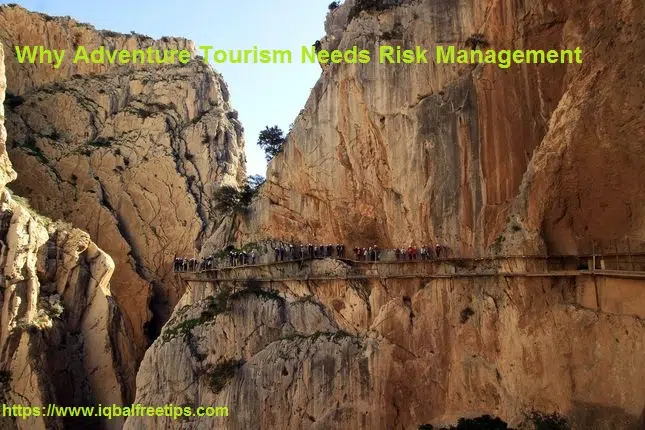
Adventure Tourism Needs Risk Management
What do you get when you combine the adrenaline rush of adventure activity with the beauty of the natural world? You get adventure tourism, which accounts for many visits to national parks and other outdoor attractions. While this type of tourism can be fun and exciting, it also comes with risks, some of which can be pretty extreme and even life-threatening. To keep everyone in your party safe, some risk management tips apply to any adventure activity.
What is Adventure Tourism?
Adventure tourism is a type of tourism that involves seeking out new and thrilling experiences. This can include bungee jumping, sky diving, or whitewater rafting. While adventure tourism can be a lot of fun, it also comes with inherent risks. Adventure tour operators need to have a solid risk management plan.
These plans can help minimize the danger for employees and clients by anticipating potential hazards or accidents. It’s especially critical to ensure safety precautions when dealing with high-risk activities such as scuba diving or mountain climbing. Also, adventure tourism companies should take the time to properly train their staff on how to handle an emergency so they can react quickly if needed.
Definition of Risk:
In business, the risk is the potential of suffering losses due to external factors beyond your control. Risk management in adventure tourism identifies, assesses, and controls risks. By managing risks, you can minimize the potential for losses and maximize the chances of success.
For example, in kayaking, there are many ways one could get injured, including being punctured by a sharp object or contracting a waterborne illness. These events are easy to identify and assess and simple to control through proper precautions such as wearing protective gear or using appropriate hand sanitizer. When it comes to more complex risks like lawsuits, on-the-job injuries, international travel issues, and natural disasters, they may be harder to predict.
What are the possible risks?
When you’re operating in the adventure tourism industry, there are a lot of potential risks that come with the territory. Everything from bad weather to equipment failures can put your guests in danger. That’s why it’s so vital to have a risk management plan in place. By identifying the risks ahead of time, you can be better prepared to deal with them if they do occur.
For example, if one of your employees is injured and has to leave work, you need to know who will cover their shifts. If a hiking trail gets closed because of an avalanche, you want to ensure that your guests are aware before they set out on the trip. Once you’ve identified the possible risks and how to mitigate them, you need to document everything. It would be best if you also established protocols for dealing with emergencies like medical emergencies or evacuations due to natural disasters.
Risk Management
When you’re managing the risks of an adventure tourism business, there are a few key things to keep in mind. First, you need to identify the risks. This includes looking at both the internal and external factors that could affect your business.
Once you’ve identified the risks, you need to come up with a plan to mitigate them. This might include things like insurance, safety protocols, and emergency procedures. Finally, you need to monitor the risks and ensure your mitigation plans are working. If they aren’t, you may need to tweak them or change them altogether. Risk management is a crucial part of adventure tourism.
Common Mistakes of Risk Management
Risk management is the process of recognizing, evaluating, and calculating risks. It is an integral part of any adventure tourism business and should be given due diligence. However, there are common mistakes that are made when managing risk. These include:
-Not identifying all the risks: It is essential to identify all the potential risks before deciding how to manage them. If not all risks are identified, there will always be a danger that something will slip through the cracks. Some examples of other types of threats in this field would be medical emergencies or injury-related accidents.
-Ignoring the severity of risk: The severity is also an essential factor in determining how much attention a particular chance should get from managers. For example, it may not make sense for a manager to spend hours implementing controls for a low-risk activity while they have time constraints with high-risk activities.
How do I achieve Risk Management?
As an adventure tourist, you’re naturally drawn to activities with a certain amount of risk. But that doesn’t mean you’re comfortable putting yourself in harm’s way without taking some precautions first. Here are a few ways to mitigate your risks and make sure you have a safe and enjoyable experience.
• Consider the level of difficulty: Does this activity seem like something I could handle?
• Read up on safety: Can I read the safety instructions before doing the activity? Will there be a person or instructor at the site during the movement who can help me if I need assistance? Is there backup equipment available just in case anything goes wrong? How much training will I receive beforehand?
For example, as exciting as zip lining might sound, you’ll want to ensure that you wear long pants, so they don’t get caught in the machinery. You should also talk to your guide about what happens if one of the cables snaps. If all else fails, you may want to consider wearing gloves, so your hands won’t slip off when holding onto handles attached to the cable. And finally think about where you’ll go after your adventure-do you know how to get back home safely? Keep these tips in mind and explore the world from a new perspective!
How much Risk Managemnet costs?
Many people see risk as something negative, but in reality, the risk is simply anything that has the potential to cause harm. And while some risks are worth taking, others are not. That’s where risk management comes in. It helps you assess what risks you can and cannot afford and then decide on a course of action. Here are three common examples of risk management for adventure tourism:
1) What if I’m injured?
2) What if my insurance company denies my claim?
3) What if I get lost?
Adventure tourism will always involve an element of risk. The best way to manage these risks is by being aware of them and educating yourself, so you know how to act accordingly. For example, it’s essential to have travel insurance before going abroad.
If your medical expenses exceed $2,000 or your accident is fatal, you will likely be covered. However, most policies exclude intentional acts like suicide. You may also want to purchase trip cancellation insurance which would help cover the cost of returning home early from your vacation due to unforeseen circumstances such as injury or illness.
Is Risk Management worth it?
Many people view adventure tourism as an extreme sport or activity with a high risk of injury or death. While there is some truth, adventure tourism can be safe and enjoyable if proper risk management is in place. By understanding the risks involved and taking steps to mitigate them, adventure tourism can be a fun and exciting way to explore the world.
However, it’s essential to do your research and be knowledgeable about any possible risks before embarking on any trip. Talk to your tour guide about what you should expect and find out what equipment will be provided for safety. Familiarize yourself with evacuation procedures before you go on the trip so you know how to get help quickly if something goes wrong. If a situation does arise where you are injured, don’t panic. Stay calm and alert others to the problem.
Risk Management and the worst outcomes
The truth is, when dealing with adventure tourism, the worst outcome is always possible. That’s why risk management is so important. Understanding the risks involved and taking steps to mitigate them can help ensure that your adventure tour goes off without a hitch.
In addition, it will give you peace of mind knowing that even if something does go wrong on the trip, you’ll be able to handle it effectively. It may also save you some stress since you won’t have to worry about what would happen in an emergency. All in all, there are plenty of reasons why you should put together a risk management plan for your adventure tours.
Conclusion:
Risk management is an integral part of adventure tourism because it helps keep tourists safe. By identifying potential risks and taking steps to mitigate them, adventure tour operators can reduce the chances of something going wrong. This protects not only tourists but also the reputation of the tour operator. A well-run adventure tour with sound risk management is more likely to be successful and generate repeat business. Without these measures, a poorly run adventure tour could result in injury or death for the participants. That would destroy the company’s reputation and possibly lead to lawsuits or even criminal charges against those responsible for operating the tours.
You may like:





This article is a breath of fresh air! The author’s unique perspective and insightful analysis have made this a truly fascinating read. I’m thankful for the effort he has put into crafting such an enlightening and provocative piece. Thank you, author, for offering your knowledge and sparking meaningful discussions through your outstanding writing!
Thank you so much for your kind words! I truly appreciate your appreciation of my article. It’s comments like yours that inspire me to keep writing and sharing my perspective. I’m delighted that you found the article fascinating and insightful, and I’m always here to engage in meaningful discussions. Your support means a lot to me. Thanks again!